Temporal Noise Analysis of Charge-Domain Sampling Readout Circuits for CMOS Image Sensors †
Abstract
:1. Introduction
2. Operating Principle and Implementation of a Gm-Cell-Based Pixel
2.1. Concept of Gm-Cell-Based Pixel
2.2. Periodic Filtering Model of the Charge-Domain CDS
3. Noise Analysis of a Gm-Cell-Based Pixel
3.1. Nonstationary Noise Theory Analysis
3.2. Equivalent Small Signal Model and Noise Gain
3.3. Noise Model of Charging Phase
3.3.1. Thermal Noise
3.3.2. Flicker Noise
3.4. Noise Model of Discharging Phase
3.5. Overall Input-Referred Noise
4. Implementation and Experimental Results
5. Conclusions
Acknowledgments
Author Contributions
Conflicts of Interest
References
- Lotto, C.; Seitz, P.; Baechler, T. A Sub-Electron Readout Noise CMOS Image Sensor with Pixel-Level Open-Loop Voltage Amplification. IEEE Int. Solid-State Circuits Conf. Dig. Tech. Papers 2011, 402–403. [Google Scholar] [CrossRef]
- Chen, Y.; Xu, Y.; Chae, Y.; Mierop, A.; Wang, X.; Theuwissen, A. A 0.7 e−rms Temporal-Readout-Noise CMOS Image Sensor for Low-Light-Level Imaging. In Proceedings of the 2012 IEEE International Solid-State Circuits Conference, San Francisco, CA, USA, 19–23 February 2012; pp. 384–385. [Google Scholar] [CrossRef]
- Yeh, S.-F.; Chou, K.-Y.; Tu, H.-Y.; Chao, C.Y.-P.; Hsueh, F.-L. A 0.66 e−rms Temporal-Readout-Noise 3D-Stacked CMOS Image Sensor with Conditional Correlated Multiple Sampling (CCMS) Technique. Proc. Symp. VLSI Circuits 2015, 53, 527–537. [Google Scholar] [CrossRef]
- Boukhayma, A.; Peizerat, A.; Enz, C. A Sub-0.5 Electron Read Noise VGA Image Sensor in a Standard CMOS Process. IEEE J. Solid-State Circuits 2016, 51, 2180–2191. [Google Scholar] [CrossRef]
- Boukhayma, A.; Peizerat, A.; Enz, C. Temporal readout noise analysis and reduction techniques for low-light CMOS image sensors. IEEE Trans. Electron Devices 2016, 63, 72–78. [Google Scholar] [CrossRef]
- Seo, M.-W.; Kawahito, S.; Kagawa, K.; Yasutomi, K. A 0.27 e−rms read noise 220 µV/e− conversion gain reset-gate-less CMOS image sensor with 0.11 µm CIS process. IEEE Electron Device Lett. 2015, 36, 1344–1347. [Google Scholar]
- Seo, M.-W.; Wang, T.; Jun, S.-W.; Akahori, T.; Kawahito, S. A 0.44 e−rms Read-Noise 32 fps 0.5 Mpixel High-Sensitivity RG-Less-Pixel CMOS Image Sensor Using Bootstrapping Reset. In Proceedings of the 2017 IEEE International Solid-State Circuits Conference (ISSCC), San Francisco, CA, USA, 5–9 February 2017; pp. 80–81. [Google Scholar] [CrossRef]
- Ma, J.; Fossum, E. Quanta Image Sensor Jot with Sub 0.3 e−rms Read Noise and Photon Counting Capability. IEEE Electron Device Lett 2015, 36, 926–928. [Google Scholar] [CrossRef]
- Ma, J.; Starkey, K.; Rao, A.; Odame, K.; Fossum, E. Characterization of Quanta Image Sensor Pump-Gate Jots with Deep Sub-electron Read Noise. IEEE J. Electron Devices Soc. 2015, 3, 472–480. [Google Scholar] [CrossRef]
- Wakashima, S.; Kusuhara, F.; Kuroda, R.; Sugawa, S. A linear response single exposure CMOS image sensor with 0.5 e− readout noise and 76 ke− full well capacity. In Proceedings of the 2015 Symposium on VLSI Circuits (VLSI Circuits), Kyoto, Japan, 17–19 June 2015; pp. C88–C89. [Google Scholar] [CrossRef]
- Yao, Q.; Dierickx, B.; Dupont, B.; Ruttens, G. CMOS image sensor reaching 0.34 e−rms read noise by inversion-accumulation cycling. In Proceedings of the International Image Sensor Workshop (IISW), Vaals, The Netherlands, 8–11 June 2015. [Google Scholar]
- Ge, X.; Theuwissen, A. A 0.5 e−rms Temporal-Noise CMOS Image Sensor with Charge-Domain CDS and Period-Controlled Variable Conversion Gain. In Proceedings of the International Image Sensor Society Workshop, Hiroshima, Japan, 30 May–2 June 2017; pp. 290–293. [Google Scholar]
- Ge, X.; Theuwissen, A. A 0.5 e−rms Temporal-Noise CMOS Image Sensor with Gm-Cell-Based Pixel and Period-Controlled Variable Conversion Gain. IEEE Trans. Electron Devices 2017, 64, 5019–5024. [Google Scholar] [CrossRef]
- Sepke, T.; Holloway, P.; Sodini, C.G.; Lee, H.-S. Noise analysis for comparator-based circuits. IEEE Trans. Circuits Syst. 2004, 56, 541–553. [Google Scholar] [CrossRef]
- Karvonen, S.; Riley, T.; Kurtti, S.; Kostamovaara, J. A quadrature chargedomain sampler with embedded FIR and IIR filtering functions. IEEE J. Solid-State Circuits 2006, 41, 507–515. [Google Scholar] [CrossRef]
- Mirzaei, A.; Chehrazi, S.; Bagheri, R.; Abidi, A. Analysis of first-order antialiasing integration sampler. IEEE Trans. Circuits Syst. I Regular Papers 2008, 55, 2994–3005. [Google Scholar] [CrossRef]
- Unser, M. Sampling-50 Years after Shannon. Proc. IEEE 2000, 88, 569–587. [Google Scholar] [CrossRef]
- Wey, H.; Guggenbuhl, W. Noise transfer characteristics of a correlated double sampling circuit. IEEE Trans. Circuits Syst. 1986, 29, 1028–1030. [Google Scholar] [CrossRef]
- Tohidian, M.; Madadi, I.; Staszewski, R.B. Analysis and design of a high-order discrete-time passive IIR low-pass filter. IEEE J. Solid-State Circuits 2014, 49, 2575–2587. [Google Scholar] [CrossRef]
- Martin-Gonthier, P.; Magnan, P. CMOS image sensor noise analysis through noise power spectral density including undersampling effect due to readout sequence. IEEE Trans. Electron Devices 2014, 61, 2834–2842. [Google Scholar] [CrossRef]
- Kawai, N.; Kawahito, S. Noise analysis of high-gain, low-noise column readout circuits for CMOS image sensors. IEEE Trans. Electron Devices 2004, 51, 185–194. [Google Scholar] [CrossRef]
- Papoulis, A. Probability, Random Variables, and Stochastic Process; McGraw-Hill, Inc.: New York, NY, USA, 1991; pp. 310–311. ISBN 0-07-048477-5. [Google Scholar]
- Terry, S.C.; Blalock, B.J.; Rochelle, J.M.; Ericson, M.N.; Caylor, S.D. Time-domain noise analysis of linear time-invariant and linear time-variant systems using MATLAB and HSPICE. IEEE Trans. Nuclear Sci. 2005, 52. [Google Scholar] [CrossRef]
- Chow, A.; Lee, H. Transient noise analysis for comparator-based switched-capacitor circuits. In Proceedings of the 2007 IEEE International Symposium on Circuits and Systems, New Orleans, LA, USA, 27–30 May 2007; pp. 953–956. [Google Scholar]
- Tian, H.; Gamal, A.E. Analysis of 1/f noise in CMOS APS. In Proceedings of the 2000 Electronic Imaging, San Jose, CA, USA, 15 May 2000; pp. 421–430. [Google Scholar] [CrossRef]
- Redeka, V. 1/f noise in physical measurements. IEEE Trans. Nuclear Sci. 1969, 16, 17–35. [Google Scholar] [CrossRef]
- Guo, W. Flicker noise process analysis. In Proceedings of the 1993 IEEE International Frequency Control Symposium, Salt Lake City, UT, USA, USA, 2–4 June 1993. [Google Scholar] [CrossRef]
- Ge, X.; Theuwissen, A. A CMOS image sensor with nearly unity-gain source follower and optimized column amplifier. In Proceedings of the 2016 IEEE SENSORS, Orlando, FL, USA, 30 October–3 November 2016. [Google Scholar] [CrossRef]
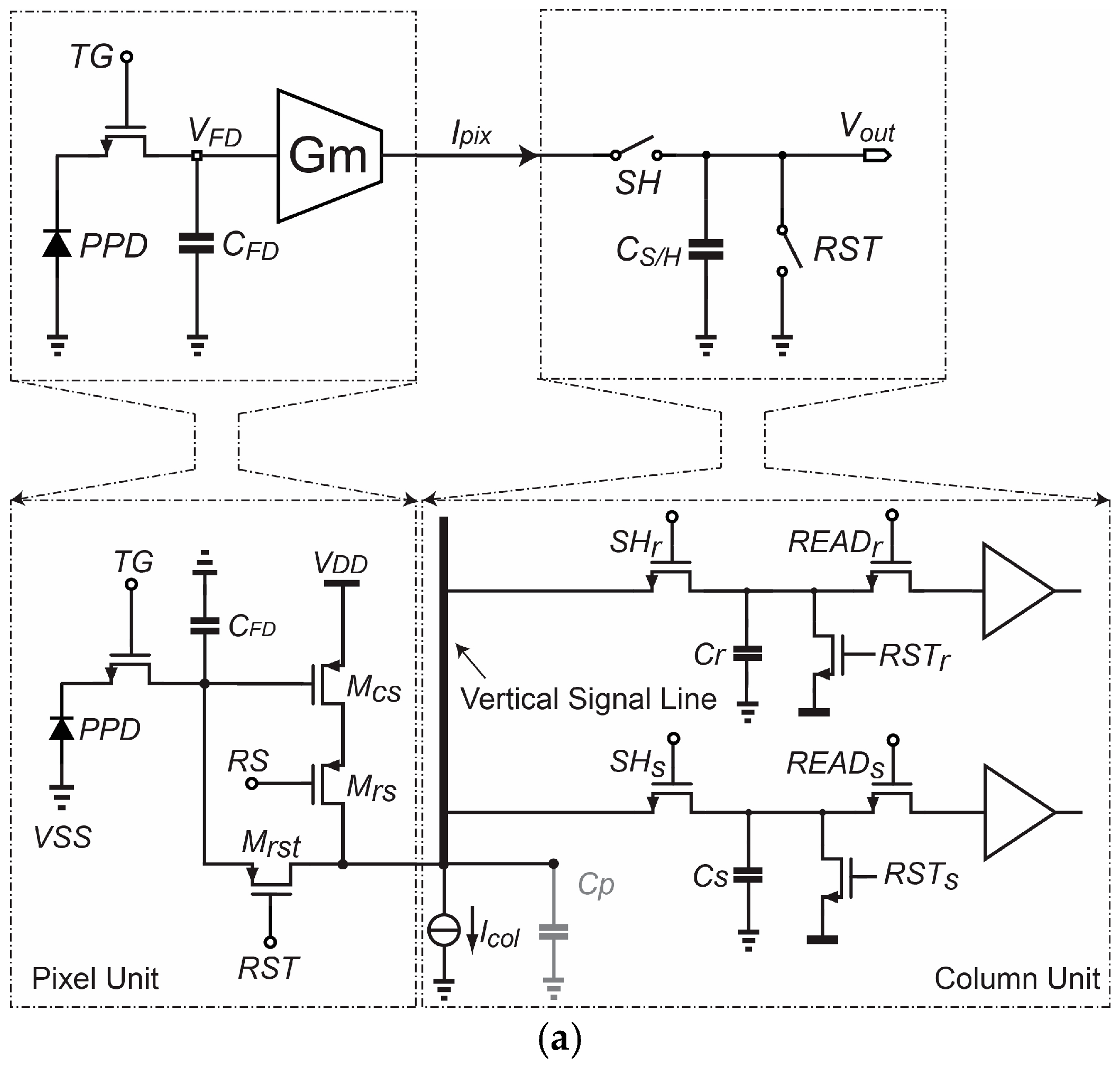
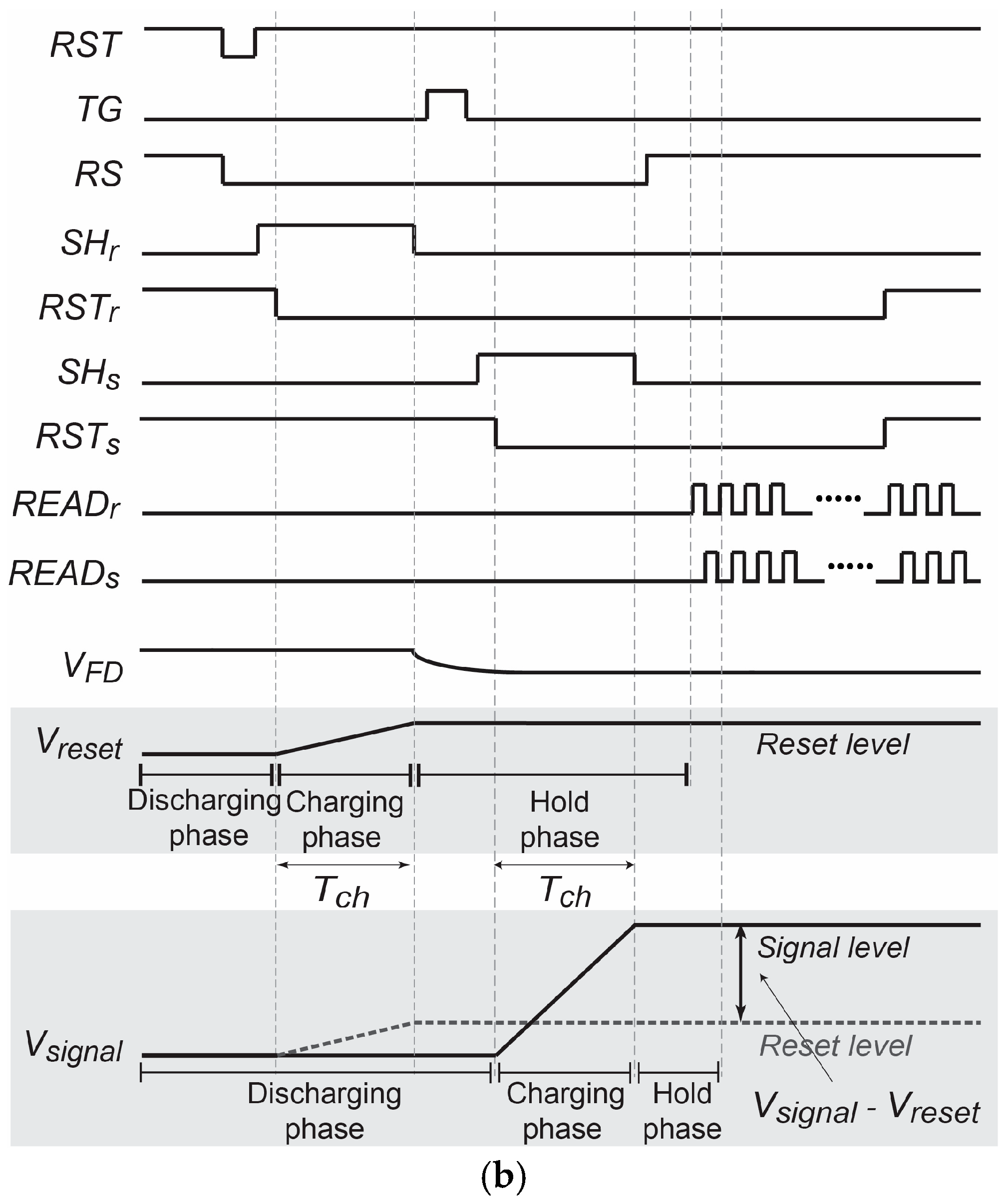
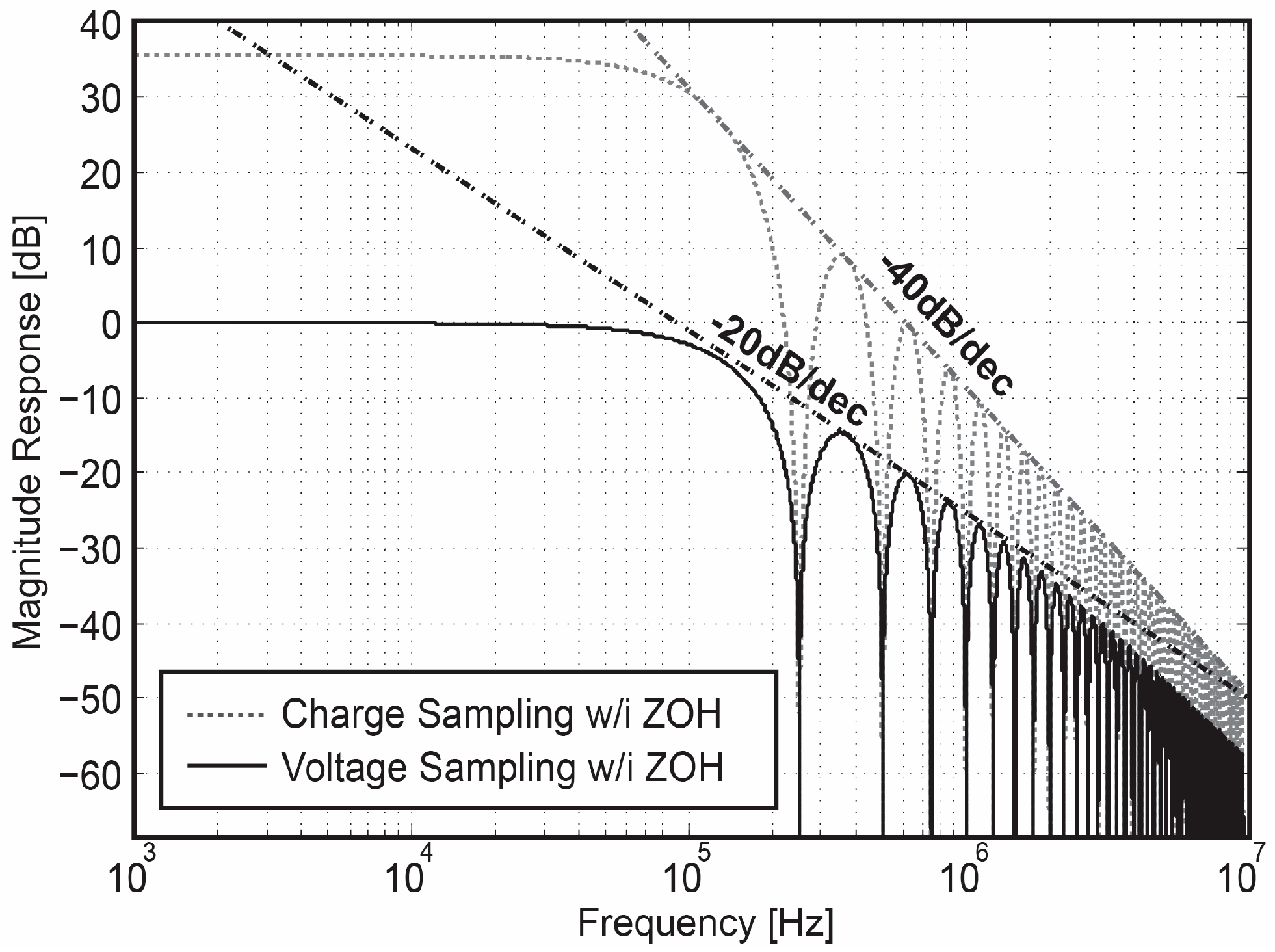
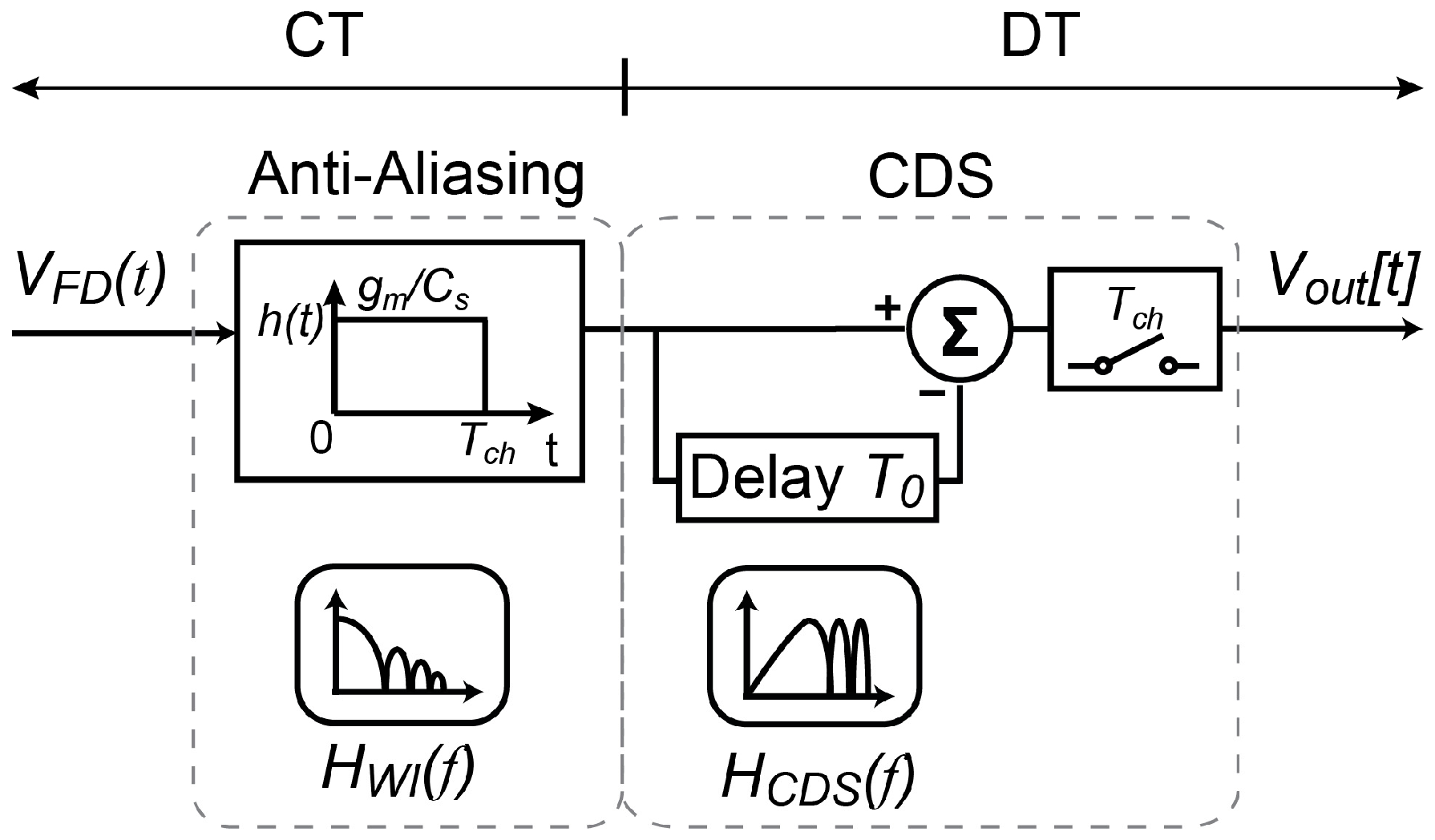
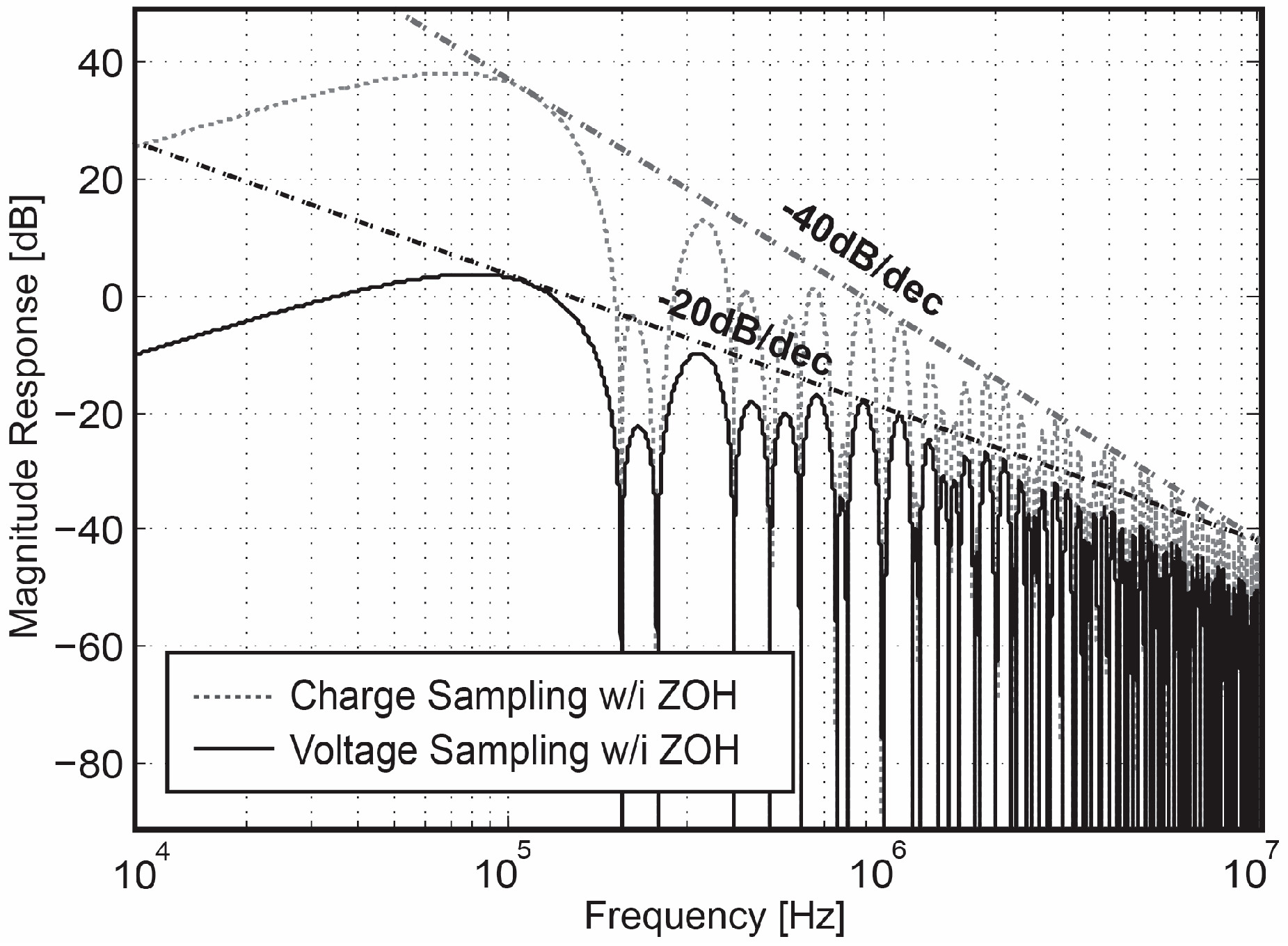
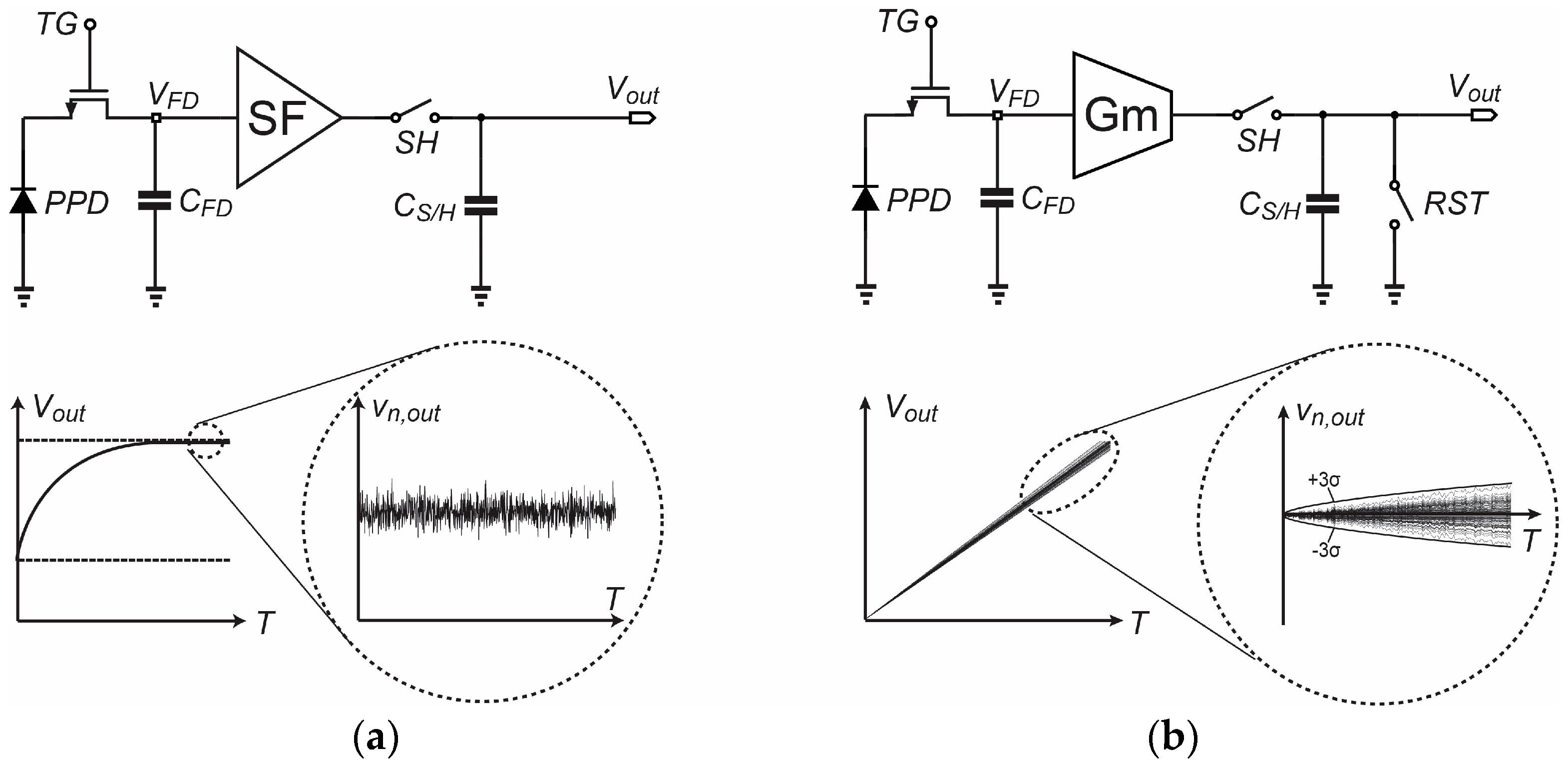
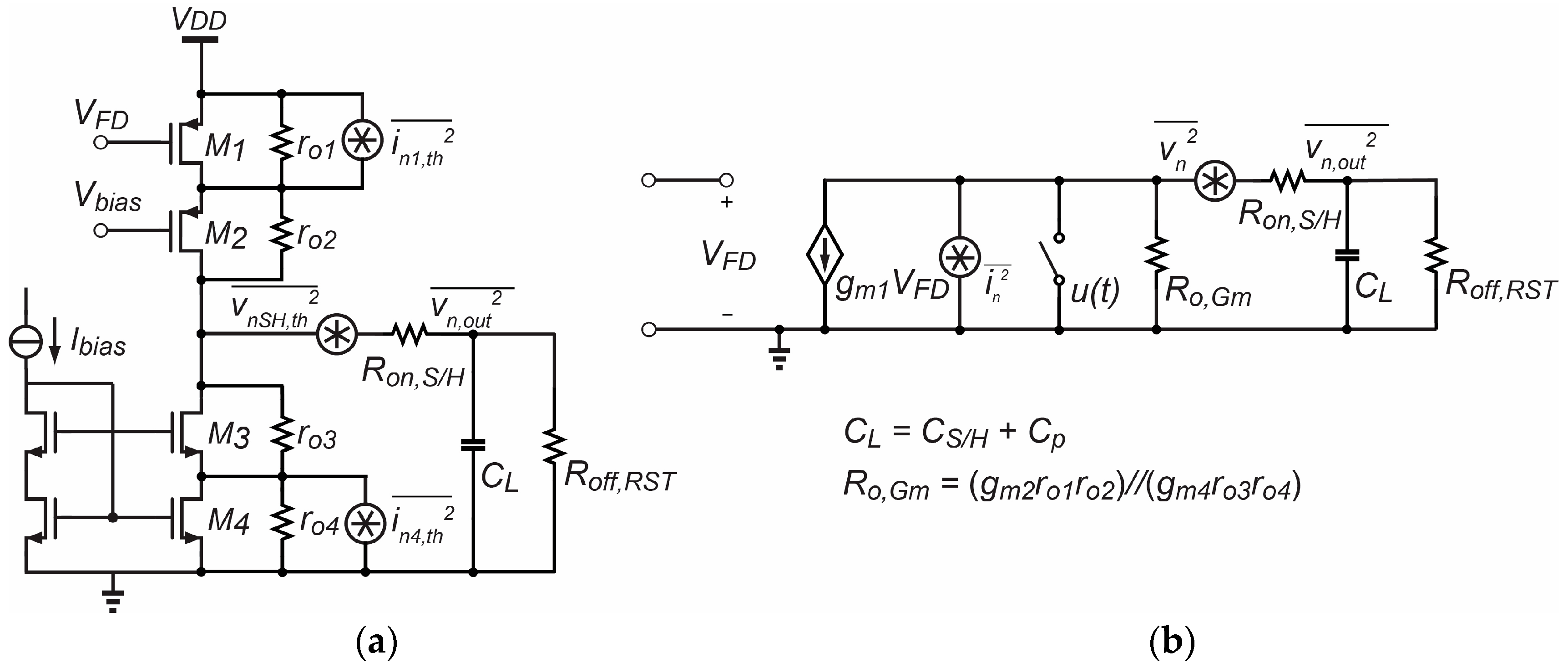

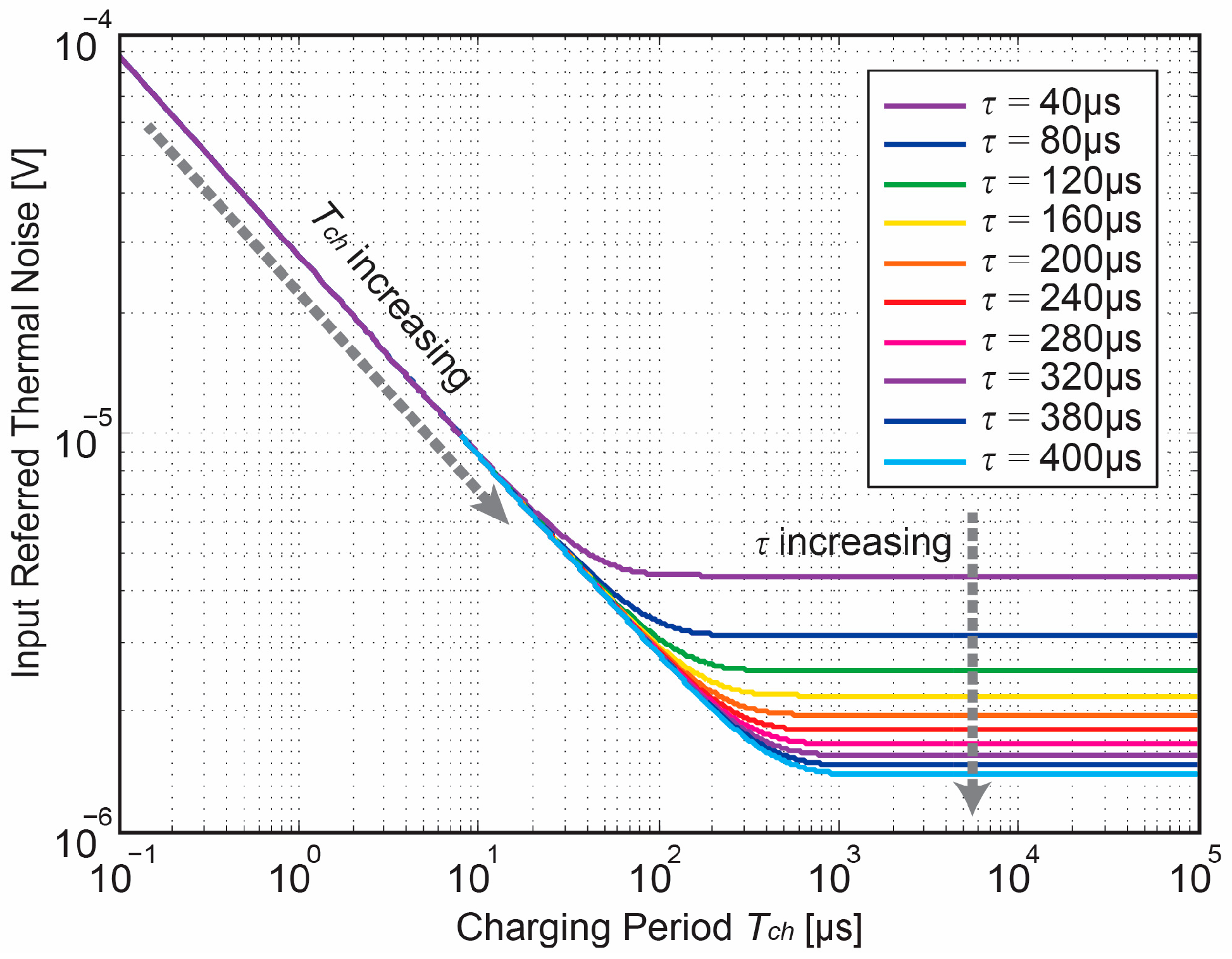
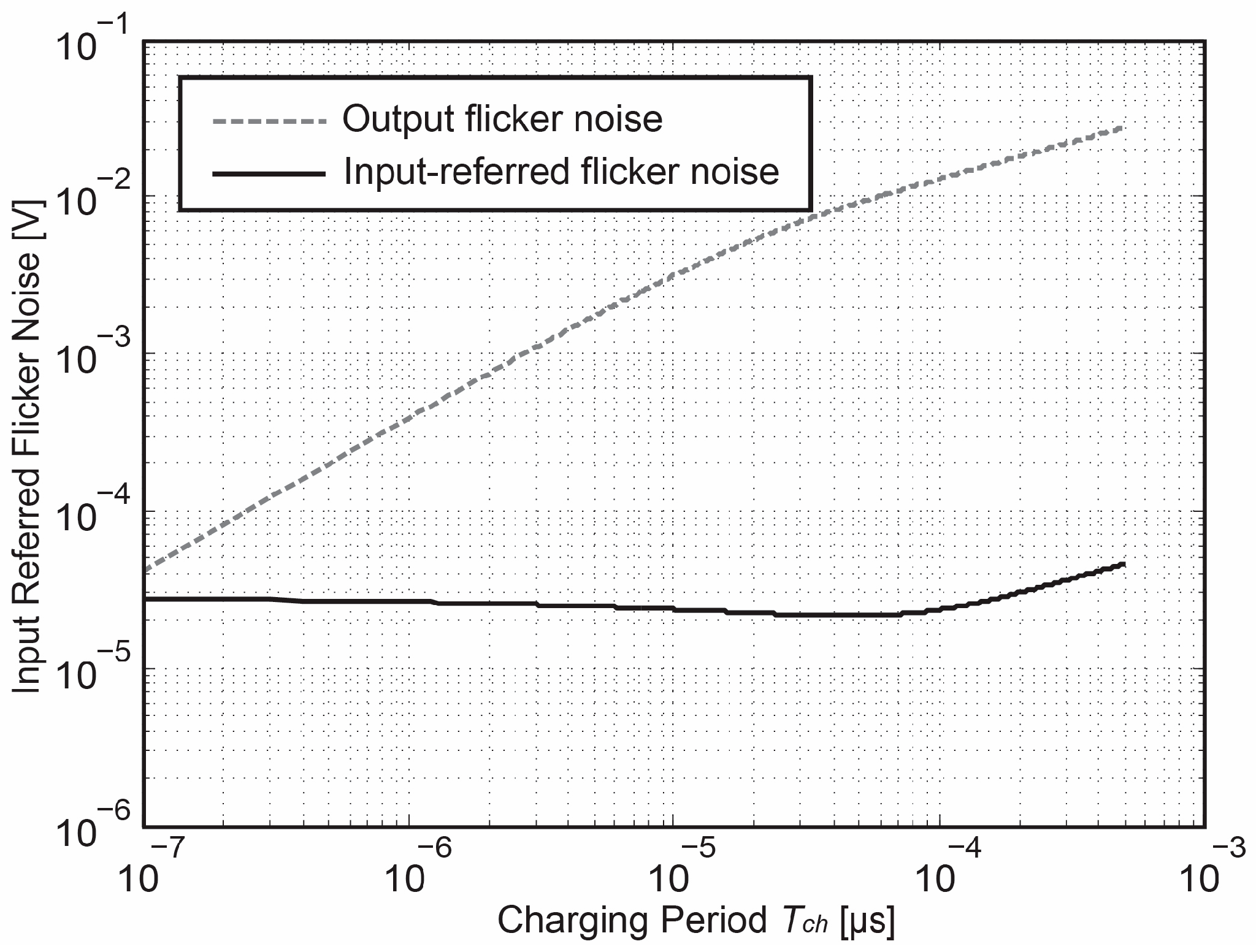

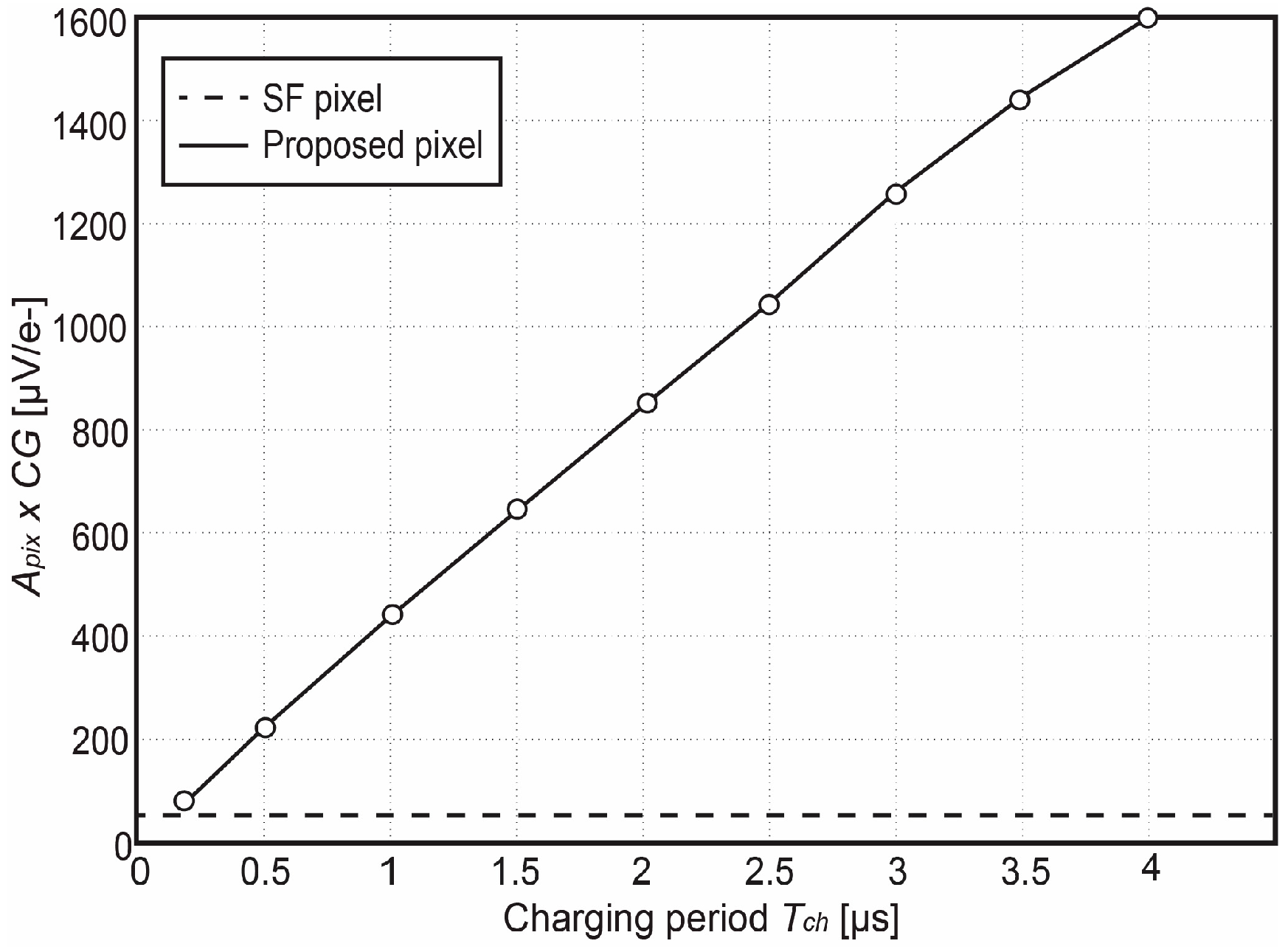
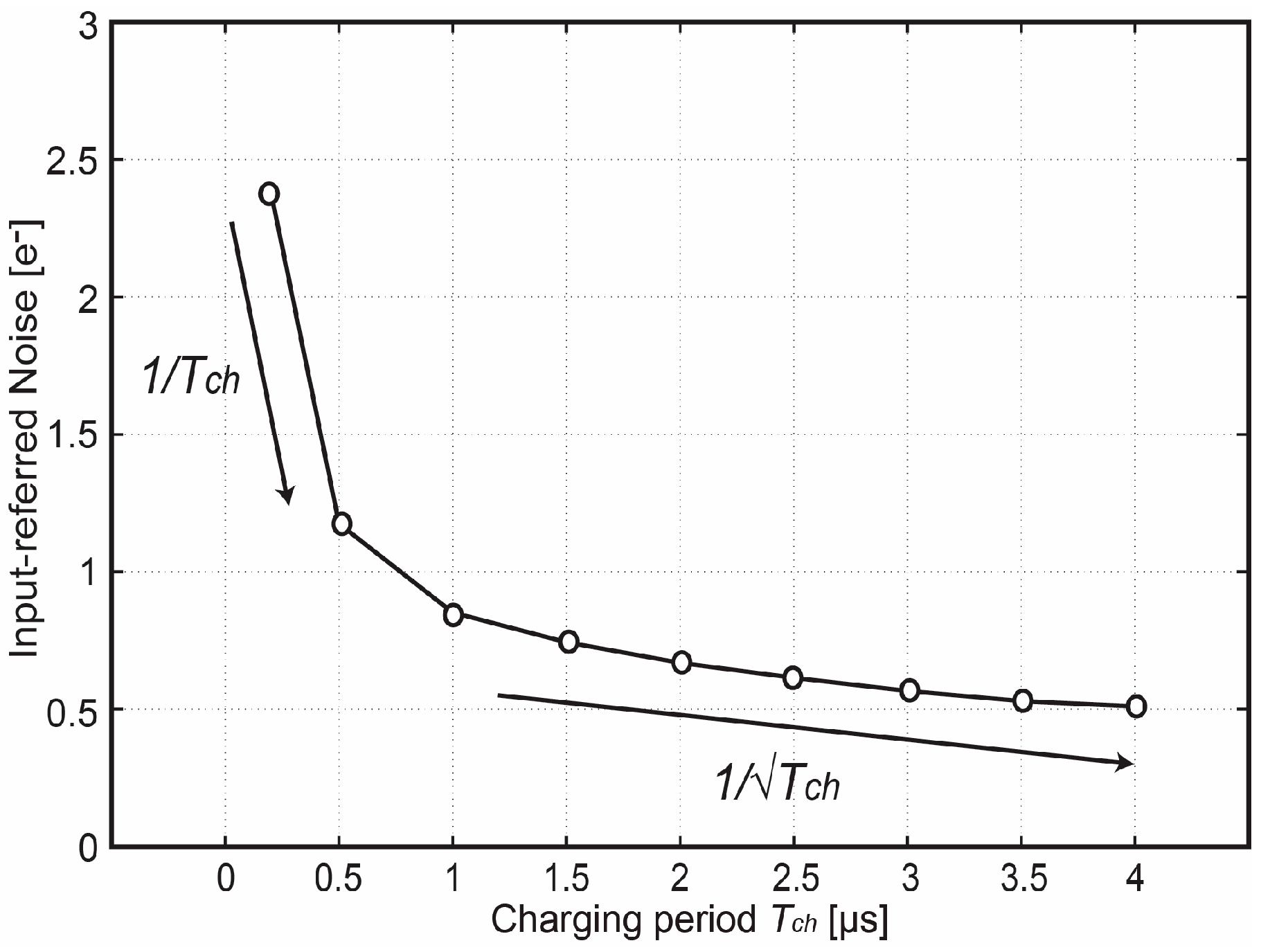
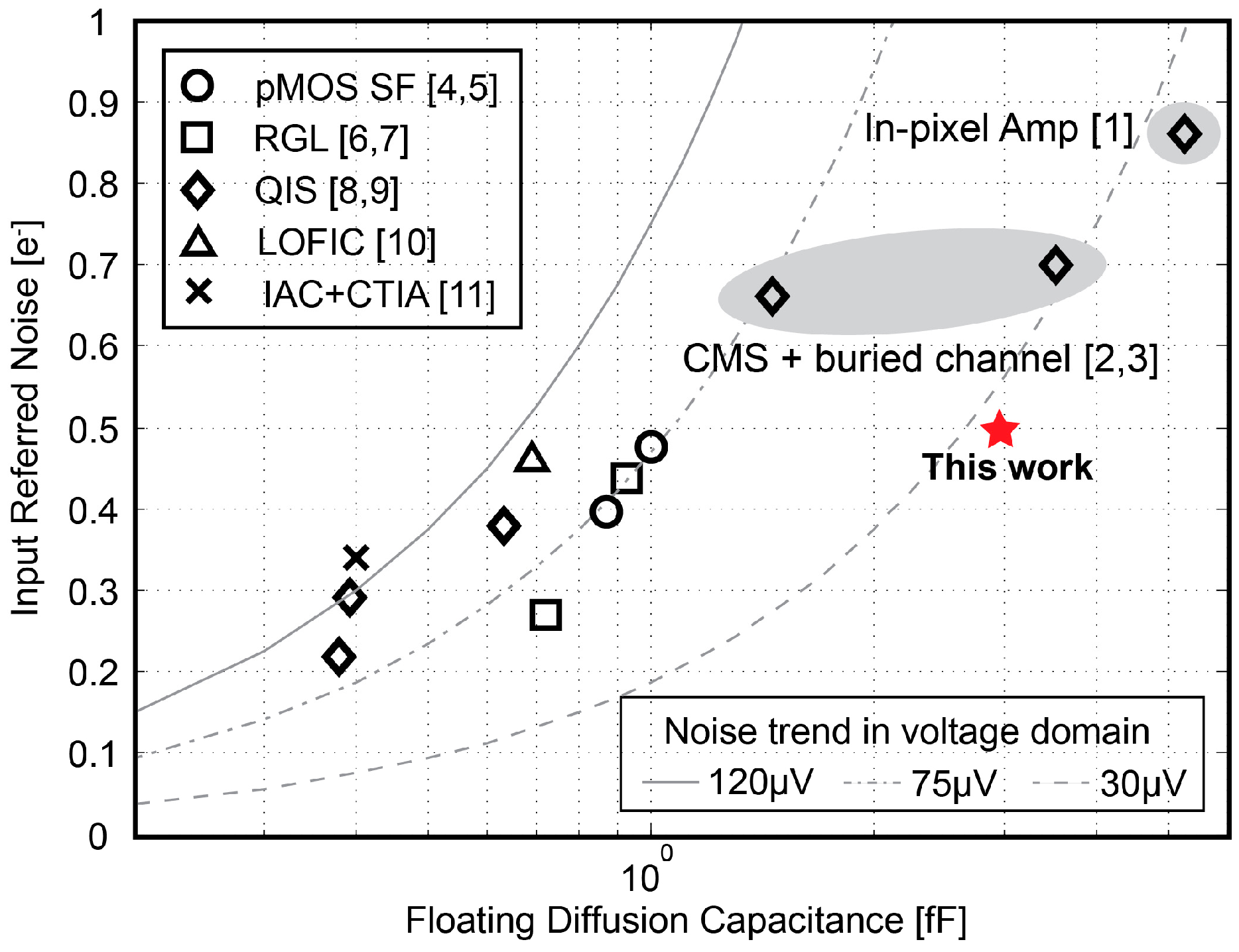

| Parameter | Value | Parameter | Value |
|---|---|---|---|
| gm1 | 30 µS | A | 3 µm (W) × 0.5 µm (L) |
| Cp | 2 pF | K | 1 × 10−25 |
| Ro,Gm | 20 MΩ | Cox | 4.3 fF/µm2 |
| k | 1.38 × 10−23 | fc | 500 kHz |
| T | 300 K | top | ~1 h |
© 2018 by the authors. Licensee MDPI, Basel, Switzerland. This article is an open access article distributed under the terms and conditions of the Creative Commons Attribution (CC BY) license (http://creativecommons.org/licenses/by/4.0/).
Share and Cite
Ge, X.; Theuwissen, A.J.P. Temporal Noise Analysis of Charge-Domain Sampling Readout Circuits for CMOS Image Sensors. Sensors 2018, 18, 707. https://doi.org/10.3390/s18030707
Ge X, Theuwissen AJP. Temporal Noise Analysis of Charge-Domain Sampling Readout Circuits for CMOS Image Sensors. Sensors. 2018; 18(3):707. https://doi.org/10.3390/s18030707
Chicago/Turabian StyleGe, Xiaoliang, and Albert J. P. Theuwissen. 2018. "Temporal Noise Analysis of Charge-Domain Sampling Readout Circuits for CMOS Image Sensors" Sensors 18, no. 3: 707. https://doi.org/10.3390/s18030707





